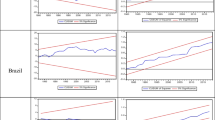Abstract
Sugarcane plays a vital role in the overall economy of Pakistan. Pakistan ranks among the top 10 sugarcane producing countries in the world. Further, Pakistan ranks among the top 10 sugar-consuming countries in the world. Due to the excessive quantity of Gur and seed manufacturing, there has been a great loss of production of refined sugar in Pakistan to meet the monthly national consumption of a country. Prediction of crop production level is necessary for policymakers in precise planning to overcome the sugar shortage and control its prices in the market. Hence, there is a dire need to develop an appropriate forecasting model for sugarcane production using time-series data for predicting future sugarcane production. The aim of this study is to evaluate the appropriate models for forecasting sugarcane production in Pakistan along its 4 provinces, namely Punjab, Sindh, Khyber Pakhtunkhwa and Baluchistan. Sugarcane production data from 1982 to 2016 were used for model structure and 2017 to 2019 was used to test the model. Auto-regressive integrated moving average (ARIMA) method was used for the selection of suitable production model. Lag order selection was carried out using AIC and SC. RMSE, MAE, MAPE and Theils’ U statistic were used to test the fitted models accuracy of the data. Results indicate that forecast accuracy of MAPE criteria ranged from 2.83 to 11.02 per cent. Results show that ARIMA (2, 1, 6), ARIMA (1, 1, 2), ARIMA (4, 1, 8), ARIMA (1, 0, 3), and ARIMA (4, 1, 2) models are most suitable models for forecasting sugarcane production in Punjab, Sindh, KP, Baluchistan and Pakistan.



Similar content being viewed by others
References
Afghan, S., W.R. Arshad, M.E. Khan, and K.B. Malik. 2022. Sugarcane breeding in Pakistan. Sugar Tech 24 (1): 232–242.
Ali, S., N. Badar, and H. Fatima. 2015. Forecasting production and yield of sugarcane and cotton crops of Pakistan for 2013–2030. Sarhad Journal of Agriculture 31 (1): 1–10.
Azam, M., and M. Khan. 2010. Significance of the sugarcane crops with special and ference to NWFP. Sarhad Journal of Agriculture 26 (2): 289–295.
Economic Survey of Pakistan. 2021. Agriculture. https://www.finance.gov.pk/survey/chapters_21/02-Agriculture.pdf. Accessed 04 June 2022.
Food and Agricultural Organization. 2020a. Countries by Commodity. https://www.fao.org/faostat/en/#rankings/countries_by_commodity. Accessed 04 June 2022.
Food and Agricultural Organization. 2020b. Crops and livestock products. https://www.fao.org/faostat/en/#data/TCL. Accessed 12 September 2022.
Mehmood, Q., M.H. Sial, M. Riaz, and N. Shaheen. 2019. Forecasting the production of sugarcane crop of pakistan for the year 2018–2030 using box-jenkin’s methodology. The Journal of Animal and Plant Sciences 29 (5): 1–6.
Mishra, P., A.M.G. Al Khatib, I. Sardar, J. Mohammed, K. Karakaya, A. Dash, M. Ray, L. Narsimhaiah, and A. Dubey. 2021a. Modeling and forecasting of sugarcane production in India. Sugar Tech 23 (6): 1317–1324.
Mishra, P., C. Fatih, H.K. Niranjan, S. Tiwari, M. Devi, and A. Dubey. 2020. Modelling and forecasting of milk production in Chhattisgarh and India. Indian Journal of Animal Researchs 54 (7): 912–917.
Mishra, P., A. Matuka, M.S.A. Abotaleb, W.P.M.C.N. Weerasinghe, K. Karakaya, and S.S. Das. 2021b. Modeling and forecasting of milk production in the SAARC countries and China. Modeling Earth Systems and Environment 8 (1): 947–959.
OECD-FAO. 2021. OECD-FAO Agricultural Outlook 2021–2030. Sugar projections: Consumption, per capita. https://www.oecd-ilibrary.org/agriculture-and-food/sugar-projections-consumption-per-capita_4ad4cf3a-en. Accessed 12 Sep 2022.
Statista. 2022. Sugar consumption worldwide in 2021/2022, by leading country (in million metric tons). https://www.statista.com/statistics/496002/sugar-consumption-worldwide/. Accessed 12 Sep 2022.
Suresh, K.K., and S.K. Priya. 2011. Forecasting sugarcane yield of Tamilnadu using ARIMA models. Sugar Tech 13 (1): 23–26.
Vishawajith, K.P., P.K. Sahu, B.S. Dhekale, and P. Mishra. 2016. Modelling and forecasting sugarcane and sugar production in India. Indian Journal of Economics and Development 12 (1): 71–80.
Yaseen, M., M. Zakria, M. Islam-ud-din-shahzad, I. Khan, and A.M. Javed. 2005. Modeling and forecasting the sugarcane yield of Pakistan. International Journal of Agriculture and Biology 7 (2): 180–183.
Author information
Authors and Affiliations
Corresponding author
Ethics declarations
Conflict of interest
The authors declare no conflict of interest in producing this article.
Additional information
Publisher's Note
Springer Nature remains neutral with regard to jurisdictional claims in published maps and institutional affiliations.
Rights and permissions
Springer Nature or its licensor (e.g. a society or other partner) holds exclusive rights to this article under a publishing agreement with the author(s) or other rightsholder(s); author self-archiving of the accepted manuscript version of this article is solely governed by the terms of such publishing agreement and applicable law.
About this article
Cite this article
Hussain, N. Predicting Forecast of Sugarcane Production in Pakistan. Sugar Tech 25, 681–690 (2023). https://doi.org/10.1007/s12355-022-01221-4
Received:
Accepted:
Published:
Issue Date:
DOI: https://doi.org/10.1007/s12355-022-01221-4



